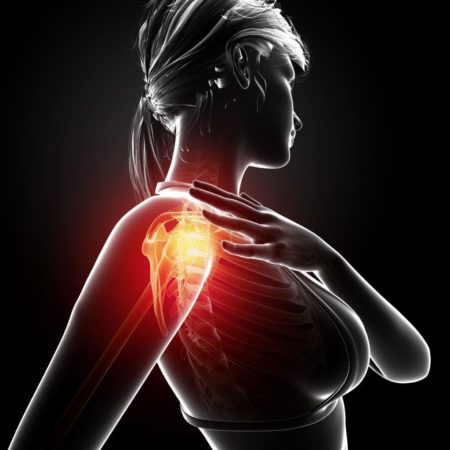This article by Merida, Yucatan Licensed Physical Therapist Briseida Montes de Oca delves into shoulder pain, one of the most common causes for a visit to the orthopaedic doctor.
Adhesive capsulitis or “frozen shoulder” is the most severe condition and it is characterized by progressive loss of movement. It is a chronic inflammation of the tissue, the shoulder joint and the capsular contracture of the joint.
It is most common in women beginning in their forties and could develop also in their sixties.
Symptoms include:
- Severe pain and stiffness, the pain manifests itself mostly in the anterior and lateral part of the shoulder leading down to the arm.
- Trouble sleeping through the night.
- Difficulty lifting the arm overhead.
- Stiffness and overall restriction of movement.
- Impairments or incapacity to perform daily life activities
The lack of muscle movement is the main cause of capsulitis. The pain can disappear on its own over time or it can develop into a more severe pain that could leave surgery as the only option.
Several authors have described the condition as difficult to treat. The origin is unknown but it is believed that there are certain pre-existing conditions like diabetes, thyroid problems, hormonal changes, cardiac and neurological issues, cancer and prolonged periods of immobilization (for example due to a fracture a tear or prior surgery of the shoulder or elbow).
Injuries to the cervical vertebrae can also contribute to a frozen shoulder condition.
An illness of visceral origin (pancreatitis) can also cause referred pain to the shoulder.
This illness can last up to 24 to 30 months. It is considered self-limiting and frequently the patients can develop capsulitis on the opposite shoulder while the other one improves.
Many times the patient does not seek medical help immediately, weeks or months pass after the pain and stiffness developed and the daily activities are severely limited. Pain can also surface in other areas of the body like the neck and upper back due to the way they compensate with other muscle movements.
How are the shoulder joints formed?
The principal joints are formed primarily by 3 groups:
- Glenohumeral joint It is a ball and socket joint formed at scapula and the humerus bone.
- Sternoclavicular joint it is the bone of the sternon that attaches to the clavicle.
- Acromioclavicular joint where the two bones, the acromion and clavicle It is also referred to as the AC joint.
These joints work in conjunction and allow the movements of the shoulder in all directions, allowing for the shoulder to perform normal and daily life activities.
Phases of Frozen shoulder
- Pain- Patients refer to the pain as localized in the lateral area of the shoulder that increases at night, especially when sleeping on the affected side. It diminishes the range of motion and this phase can last between 2 to 9 months.
- Limited mobility- Stiffness and limited range of motion. Greatly diminishes daily life activity for example bathing combing hair, reaching objects overhead. The pain can diminish on its own. This phase can last between 4 to 12 months.
- Recovery stage- The pain and mobility tend to improve progressively. This phase can last between 6 to 9 months.
It is recommended that the person seek professional medical assistance from an Orthopaedic doctor or a Licensed Physical therapist.
The orthopaedic doctor will evaluate the patient and use a series of clinical test (MRI, X RAYS, CAT SCAN, ULTRASOUND) to determine the level of injury.
The Physical Therapist will evaluate the condition after a series of specific functfional test to determine what type of techniques or therapies will be used during the course of the treatment.
- Manual therapy (Movement and stretching at the joint level)
- Massage
- Electro stimulation
- A therapeutic exercise program
- Heat therapy
- Ice therapy.
Some therapist offer at home rehabilitation care which is a great option for many patients. A good therapist should not only help with your frozen shoulder but should also guide you in healthy habits and the right type of exercise for your individual needs. A good therapist should work with you to correct and maintain good posture and prevent futures issues.
References:
- Reeves B. The natural history of the frozen shoulder síndrome.1975; 4: 198-196.
- Keith L. Moore,Arthur F. Dalle. Anatomía con orientación clínica. 5a ed. México, Medica Panamericana, 2007.
- Serrano Ardila, Ana María; Abush Torton, Sergio. Capsulitis adhesiva. 2017; 62 (1):37-43.
By Briseida Montes de Oca for TYT
 Briseida Montes de Oca is a full time, licensed physical therapist, with a client base that includes several expats in Merida, Yucatan. She holds degrees from Universidad del Valle de México (México) y Universidad Europea de Madrid (Spain). Her experience includes working full time as a Physical Therapist in the private sector and helping patients in Mexico city for over six years.
Briseida Montes de Oca is a full time, licensed physical therapist, with a client base that includes several expats in Merida, Yucatan. She holds degrees from Universidad del Valle de México (México) y Universidad Europea de Madrid (Spain). Her experience includes working full time as a Physical Therapist in the private sector and helping patients in Mexico city for over six years.
Contact:
55 2248 1045
Disclaimer: The facts provided in this article are for general information, and should not be construed as medical advice endorsed by The San Miguel Times.



